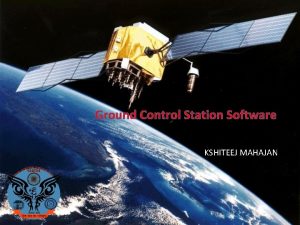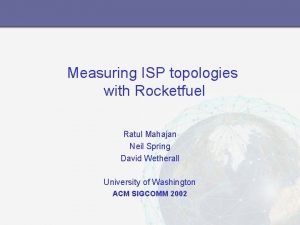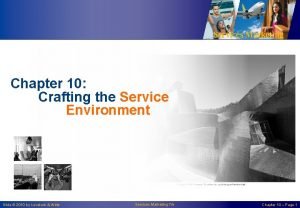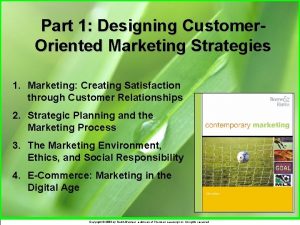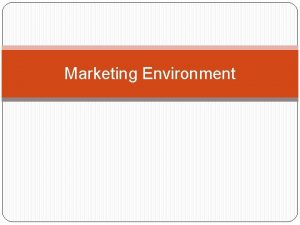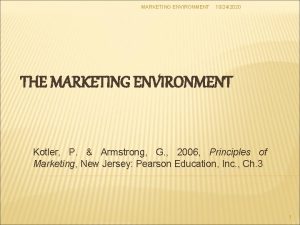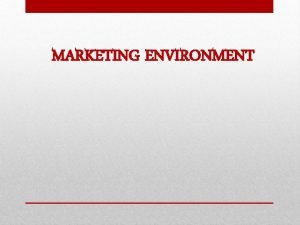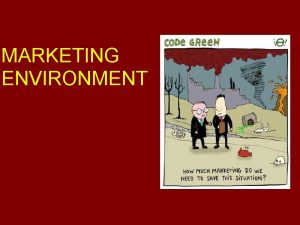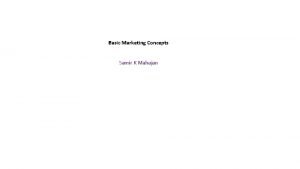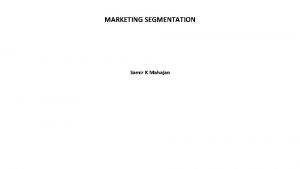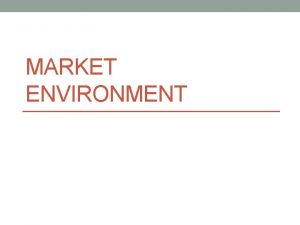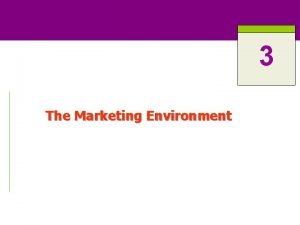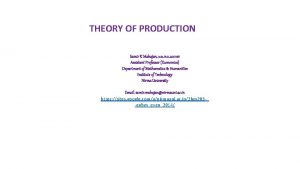MARKETING ENVIRONMENT Samir K Mahajan Samir K Mahajan
















- Slides: 16

MARKETING ENVIRONMENT Samir K Mahajan

Samir K Mahajan

PURPOSE OF MARKETING ENVIRONMENT ANALYSIS o To observe and know where the environment is heading (such as relevant events and their trends etc) , and to project where each factor of the environment will be at a future point of time. o To discern which events and trends are favourable from the standpoint of the firm, and which are unfavourable; to figure out the opportunities ( and shortlist those that have favourable impact on the business), and trace out the threats hidden in the environmental events and trends. o To help secure the right fit between the environment and the business unit, which is the crux of marketing; to help the business unit respond to environment o To facilitate formulation of a marketing strategy in the right way— in line with the trends in the environment and the opportunities emerging therein. Samir K Mahajan

MARKET ENVIRONMENT: MEANING The market environment refers to factors and forces that affect a firm’s ability to build and maintain successful relationships with customers. Two levels of marketing environment are q Micro environment q Macro environment Samir K Mahajan

MICRO ENVIRONMENT The micro environment refers to the small forces that are close to the company and affect its ability to serve its customers. It includes the company itself, its suppliers, marketing intermediaries, customer markets and public. Microenvironment may be internal and external. q Internal Micro Environment : Internal micro environment or company aspect of micro-environment refers to the internal environment of the company. This includes all departments, such as management, finance, research and development, purchasing, operations and accounting, personnel. Each of these departments has an impact on marketing decisions. For example, research and development have input as to the features a product can perform and accounting approves the financial side of marketing plans and budget in customer dissatisfaction. q External Micro-environment/ Meso-Environment : External Micro-environment or also called meso-environment refer to the industry in which a company operates and the industry’s market(s). Meso-environment includes: o Marketing Intermediaries o Customers o Suppliers o Competitors o Public Samir K Mahajan

MICRO ENVIRONMENT contd. o Marketing Intermediaries: Marketing intermediaries refers to resellers, physical distribution firms, marketing services agencies, and financial intermediaries. These are the people that help the company promote, sell, and distribute its products to final buyers. Resellers are those that hold and sell the company’s product. They match the distribution to the customers and include places. Physical distribution firms are places such as warehouses that store and transport the company’s product from its origin to its destination. Marketing services agencies are companies that offer services such as conducting marketing research, advertising, and consulting. Financial intermediaries are institutions such as banks, credit companies and insurance companies. o Customers: There are different types of customer markets including consumer markets, business markets, government markets, international markets, and reseller markets. The consumer market is made up of individuals who buy goods and services for their own personal use or use in their household. Business markets include those that buy goods and services for use in producing their own products to sell. This is different from the reseller market which includes businesses that purchase goods to resell as is for a profit. These are the same companies mentioned as market intermediaries. The government market consists of government agencies that buy goods to produce public services or transfer goods to others who need them. International markets include buyers in other countries. o Suppliers: Suppliers are the people who provide necessary resources (raw materials, intermediate goods and services) needed to produce goods & services. Policies of the suppliers have a significant influence over the marketing manager’s decisions. A company must build cordial & long-term relationship with suppliers. E. g. A company that provides microprocessors to a major computer business is an example of a supplier. Samir K Mahajan

MICRO ENVIRONMENT contd. o Competitors : Competitors include rival companies with similar offerings for goods and services and substitutes that a buyer might consider. A prudent marketing manager ha to identify his competitor’s strategies, build his plans to overtake them in the market to attract competitor’s consumers towards his products. Any company faces four types of competition: ü Brand Competition i. e. competition between various companies producing similar products. e. g. competition between LG and Samsung companies ü Product Form Competition: i. e. competition between companies manufacturing products, which are similar offerings and substitutes to each other e. g. competition between coke and Pepsi (similar offerings) , cold rinks and ice-cream ( substitutes) ü Desire Competition: i. e. Competition with other companies producing diverse products. e. g: competition between the manufacturers of TV sets & all other companies manufacturing various products like automobiles, washing machines, etc. To understand the competitive situation, a company must understand the nature of market. Nature of the market may be as follows: ü Perfect Market ü Monopolistic Market ü Oligopoly ü Monopoly Samir K Mahajan ü Duopoly

MICRO ENVIRONMENT contd. o Public: A Company’s obligation is not only to meet the requirements of its customers, but also to satisfy the various groups. A public is defined as “any group that has an actual or potential ability to achieve its objectives”. The significance of the influence of the public on the company can be understood by the fact that almost all companies maintain a public relation department. A positive interaction with the public increase its goodwill irrespective of the nature of the public. A company has to maintain cordial relation with all groups. Public may or may not be interested in the company, but the company must be interested in the views of the public. Public may be various types. They are: ü Press: This is one of the most important group, which may make or break a company. It includes journalists, radio, television, etc. Press people are often referred to as unwelcome public. A marketing manager must always strive to get a positive coverage from the press people. ü Financial Public: These are the institutions, which supply money to the company. Eg: Banks, insurance companies, stock exchange, etc. A company cannot work without the assistance of these institutions. It has to give necessary information to these public whenever demanded to ensure that timely finance is supplied. ü Government: Politicians often interfere in the business for the welfare of the society & for other reasons. A prudent manager has to maintain good relation with all politicians irrespective of their party affiliations. If any law is to be passed, which is against the interest of the company, he may get their support to stop that law from being passed in the parliament or legislature. ü General Public: This includes organizations such as consumer councils, environmentalists, etc. as the present day concept of marketing deals with social welfare, a company must satisfy these groups to be successful. Samir K Mahajan

MACRO-ENVIRONMENT Macro-environment refers to the larger/ broad societal forces that affect the microenvironment and shape the activities of every business and non-profit marketer. Macro-environment consist of external forces such as Sociocultural forces, demographic factors, economic factors, scientific and technical knowledge, and political and legal factors at work in the marketing world. These are the forces over which marketers have much less control. are the forces that make up a company’s external marketing environment. These factors—and changes in them—present both threats and opportunities that require shifts in marketing plans. To spot trends and other signals , marketers must continually monitor the environment in which their companies operate. Macro-environment can be divided into o physical environment o socio-cultural forces o demographic factors o economic factors o scientific and technical knowledge, o political and legal factors Samir K Mahajan

MACRO-ENVIRONMENT contd. q Physical Environment: Natural resources and other aspect of the natural world influence marketing activities. The analysis of the mega environment must cover aspects like extent of endowment of natural resources in the country , ecology , climate, etc. These constitute the natural environment. o Natural resources: The availability of natural resources may have a direct and far-reaching impact on marketing activities of a firm in a geographic region. Areas rich in petroleum, for example, may concentrate on the production and marketing of petro products. The extent to which a country/region is endowed with these resources has an impact on the functioning of the firms. Raw materials and energy are major part of these resources, and firms are concerned with their availability as well as their cost. o Climate : Climate also greatly influences the timing of marketing activities. Production as well as sale of output of firms greatly depends on climate. These firms have to study the climate in-depth and decide their production locations and marketing territories appropriately. It is not difficult to understand why umbrella sales are greater in rainy Meghalaya than in desert-like Rajasthan or why more winter clothing is sold in Himachal Pradesh than in Tamil Nadu. o Ecology: In modern times, all societies are very much concerned about ecology , especially about issues like environmental pollution, protection of wild life and ocean wealth. As governments are becoming active bargainers in environmental issues, business firms will have to know the nature and dimensions of environmental regulations and to what extent these factors will affect their business prospects. They also need to know the role of environmental activists in the region and growing environmental issues. A company has to adopt its policies within the limits set by nature. A man can improve the nature but cannot find an alternative for it. Nature offers resources, but in a limited manner. Companies must find the best combination of production for the sake of efficient utilization of available resources. Otherwise, they may face acute shortage of resources. e. g: petroleum products, power, water, etc. Samir K Mahajan

MACRO-ENVIRONMENT contd. q Socio-cultural Forces: Most of us purchase because of the influence of social & cultural factors. Each society has its own culture. Culture is a combination of various factors such as institutions, values (reflecting abstract ideas about what is good and bad, right, and wrong, desirable and undesirable), beliefs, the lifestyle , behaviours of a society which are transferred from older generations & which are acquired. Consumer’s behaviour is guided by our culture, family, educational institutions, languages, etc. A marketing manager must study the society in which he operates. Consumer’s attitude is affected by their society within a society, there will be various small groups, each having its own culture. Social class determined by income, occupation location of residence, etc of its members , work ethic , notion of equality and freedom, changing position of woman transformed from simple house wife to a educated employed member deeply affect sales position of a firm. The marketing manager should take note of these differences before finalizing the marketing strategies. Culture changes over a period of time. In recent times, some changes are taking place in the culture arena, owing to increased exposure to different lifestyles, impact of the media, increasing industrialisation and consequent mobility of population, and the process of globalisation. Marketers must try to anticipate the changes new marketing opportunities. It is the marketer ’ s job to “read” the social environment and reflect the surrounding culture’ s values and beliefs in a marketing strategy Samir K Mahajan

MACRO-ENVIRONMENT contd. q Demographics: Demography is the study of the size, composition, and distribution of the human population in relation to social factors such as geographic boundaries. This is one of the most influencing factors because it deals with the people who form the market. A company should study the population, its distribution, age composition, etc before deciding the marketing strategies. Each group of population behaves differently depending upon various factors such as age, status, etc. if these factors are considered, a company can produce only those products which suits the requirement of the consumers. In this regard, it is said that “to understand the market you must understand its demography”. Other demographic attributes like migration from rural to urban areas, growing urbanization, age and generations, work force changes , single-person household, working women, family and household income, a multi-linguistic and multi-cultural population, generation gaps etc must be considered by marketers in developing products and marketing strategy. Study of population characteristics is important for marketers as it helps to divide the population into market segments and target markets. An example of demography is classifying groups of people according to the year they were born. These classifications can be referred to as baby boomers who are born between 1946 and 1964, generation X who are born between 1965 and 1976, and generation Y who are born between 1977 and 1994. Each classification has different characteristics and causes they find important. This can be beneficial to a marketer as they can decide who their product would benefit most and tailor their marketing plan to attract that segment. Samir K Mahajan

MACRO-ENVIRONMENT contd. q Science and Technology: Although the two terms are sometimes used interchangeably , science is the accumulation of knowledge about human beings and the environment, and technology is the application of such knowledge for practical purposes. From customer’s point of view, improvement in technology means improvement in the standard of living. In this regard, it is said that “Technologies shape a Person’s Life”. Every new invention builds a new market & a new group of customers. A new technology improves our lifestyle & at the same time creates many problems. Eg: Invention of various consumer comforts like washing machines, mixers, etc have resulted in improving our lifestyle but it has created severe problems like power shortage. Eg: Introduction to automobiles has improved transportation but it has resulted in the problems like air & noise pollution, increased accidents, etc. Television changed the way people think about news and entertainment. Digital Technology and the Internet has brought remarkable changes in people’s thought perceptions and life, has transformed society and brought enormous opportunities for the marketers too. Time is collapsing. Distance is no longer an obstacle. “Instantaneous” has a new meaning. The Internet is the most important communication medium to come along since television. The Internet, as a new medium for our new era, is a macro-environmental force that is having a profound impact. The Internet is changing everything—especially commerce. e-commerce is the business model for the millennium and that marketing’s role has been changed for ever by the Internet. In simple words, following are the impacts of technological factors on the market: • They create new wants • They create new industries • They may destroy old industries • They may increase the cost of Research & Development. Samir K Mahajan

MACRO-ENVIRONMENT contd. q Economic Environment: Economic environment refers to the purchasing power of potential customers and the ways in which people spend their money. Within this area are two different economies, subsistence and industrialized. Subsistence economies are based more in agriculture and consume their own industrial output. Industrial economies have markets that are diverse and carry many different types of goods. Each is important to the marketer because each has a highly different spending pattern as well as different distribution of wealth. A company can successfully sell its products only when people have enough money to spend. The business cycle causes recurrent fluctuations in general economic activity in most of the nations of the world, and affects a consumer’s purchasing behavior either by increasing his disposable income or by reducing it. The various booms and busts in the health of an economy influence unemployment, inflation, and consumer spending and saving patterns which, in turn, influence marketing activity. Political and Legal Factors: The political environment such as the practices and policies of governments and the legal environment such as laws and regulations and their interpretation etc. affect marketing activity in several ways. In general, the political environment includes all laws, practices and policies of governments, government agencies, and groups that influence or limit other organizations and individuals within a society. They can limit the actions marketers are allowed to take and put restriction on their activities. It is important for marketers to be aware of these restrictions as they can be complex. Some products are regulated by both state and union government laws. There are even restrictions for some products as to who the target market may be, for example, cigarettes should not be marketed to younger children. There also many restrictions on formation of monopolies. Samir K Mahajan

MACRO-ENVIRONMENT contd. Businesses have to operate within the framework of the prevailing legal environment. They have to understand the implications of all the legal provisions relating to their business. In recent times, the world over, legislation regulating businesses has been steadily increasing. And it is particularly true for India. Along with recent reforms and liberalisation, business firms operating in India are still required to grapple with a heavy load of legislation with respect to Corporate affairs, consumer protection, employee protection, corporate protection (protecting companies from each other, preventing unfair competition, protection of society as a whole against unbridled business behaviour, regulations on products, prices and distribution). Companies operating their businesses in global markets must pay attention to international laws governed by WTO, and the laws of foreign lands. Samir K Mahajan

MACRO-ENVIRONMENT contd. Source : Philip Kotler and internet
 Meera mahajan
Meera mahajan Kshiteej mahajan
Kshiteej mahajan Amitt framework
Amitt framework Sunita mahajan
Sunita mahajan Cedeiser
Cedeiser Meera mahajan
Meera mahajan Mahajan meaning
Mahajan meaning Sunita mahajan
Sunita mahajan Mandar mahajan
Mandar mahajan Ratul mahajan
Ratul mahajan Ratul mahajan
Ratul mahajan Financial environment of business
Financial environment of business Sports marketing environment matrix
Sports marketing environment matrix Service environment
Service environment Marketing environment framework
Marketing environment framework Market actors definition
Market actors definition Philip kotler marketing environment
Philip kotler marketing environment

